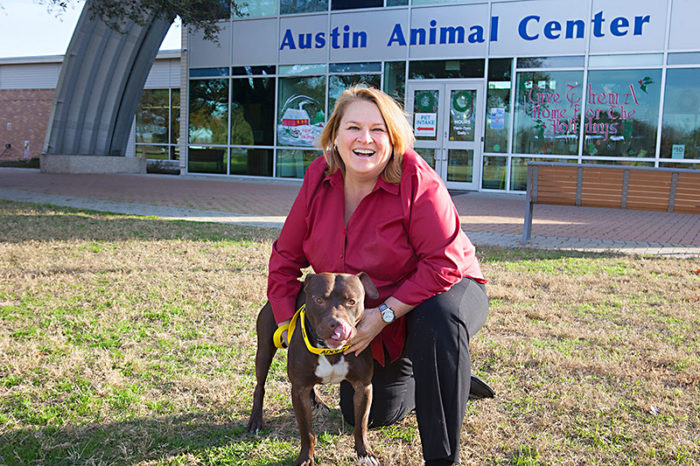Austin Animal Center, one of the largest and first municipal shelters in the nation to achieve a 90% or better save rate for the last 8 years, is frequently at capacity which means that the kennels are occupied with pets.
It’s not uncommon for staff to keep a dog or cat in their offices while waiting for adoption or a foster home. In extreme circumstances (weather emergencies, hoarding cases, seasonal increases, etc) they will set up temporary large crates in the multipurpose room while staging for fosters or rescues.
In the past when the shelter was near or at capacity, staff selected pets to kill to make space and empty out kennels. Today, as part of the Austin no-kill strategy and communication plan, animal services staff posts on the center’s social media platforms and contacts the media asking the community for assistance because no-kill is a community value, commitment and investment.
No-kill is not achieved by the shelter alone but rather is an achievement of the community by working hand in hand with partner organizations. No-kill animal services are rooted in transparency and integrity because every life matters and the killing isn’t hidden. Asking the community for assistance is fundamental to a no-kill strategic plan.
No-kill means that 100% of the animals who can be saved will be saved. Under the no-kill philosophy, animals who are irremediably suffering or too dangerous to be adopted are humanely euthanized, but the shelter strives to find a loving home for every other animal, while still ensuring high standards of care.
Socioeconomically challenged, and culturally diverse populations are inordinately affected by discriminatory housing practices and lack of affordable pet wellness services and many medical situations coming into shelters could have been prevented with basic wellness checkups on a regular basis.
As animal services professionals we cannot solve for institutionalized housing discrimination and societal inequities, but we can recognize how it contributes to people being forced to give up their family pets. We can work with other agencies, organizations and non-profits to help get in front of the crisis’s that we handle daily. Pets do not belong in shelters. They belong at home with their families unless it is an emergency and there is no other choice.
So what can we do long term? We can start a community coalition with other departments, organizations and businesses that focus on issues like housing challenges, real estate management policies, domestic violence assistance, affordable veterinarian care, emergency aid in crisis, homelessness and other subjects contributing to pets coming into shelters.
A shelter full of companion animals’ is absolute proof that no-kill sheltering is not only feasible, but it is working exactly as it should. That same shelter full of pets also tells us that as a community we still have work to do.
Critics also point to Austin’s increased animal services budget as indicative of a problem with no-kill animal sheltering, as if under funding animal services is acceptable.
Let’s put the expense issue in perspective. If our house was on fire, we would expect state of the art firefighting equipment to show up and not a horse drawn wagon with firefighters throwing buckets of water on the flames. So how is the appropriate funding of animal services somehow proof that no-kill animal sheltering is problematic?
Austin’s animal services budget has grown over a decade and according to a study conducted by the University of Denver, over 150 million dollars related to companion animals has been pumped into the local economy over a six year period.
Critics of no-kill animal services and some ill prepared or biased journalists, will not use the clear definition of what no-kill sheltering is and instead point to stories about hoarding and erroneous information taken out of context to cast doubt and stoke confusion.
Shelters full of adoptable pets, transitioning to rescues and foster homes or being returned to their homes, is what no-kill looks like right now. The goal is to keep pets in their homes, return them to their homes or find them new homes.
No-kill sheltering will look much different in the future. We will be solving for issues that contribute to people giving up a pet and pets will not be entering shelters like they are today. The lifesaving will be before the door in collaborative holistic community solutions.
We have reduced the killing of pets in shelters from 20 million annually to under 1 million in the span of 40 years and transformative change is accelerating thanks to a lot of hard work and intentional planning and actions to stop the killing.
We have a decision to make. We can choose to be constructive and problem solving, or we can be armchair critics making the life and work of those in the lifesaving arena even more difficult than it already is.
https://resources.bestfriends.org/article/no-kill-resolution-guidelines#WhatItMeans


Thanks
What you have to say gives me hope that someday we will not have the terrible overpopulation and killing issues that we have today…Praying it makes it down here to Corpus Christi, TX sooner than later. Thank you for all you do!
❤️🐾❤️🐾❤️
Great content! Super high-quality! Keep it up! 🙂